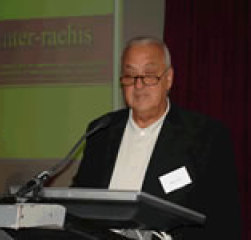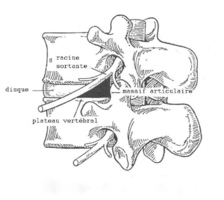
TRANSFORAMINAL ENDOSCOPIC DISCECTOMY
AFTER FAILED BACK SPINAL SURGERY
Eric GOZLAN, MD; Paris - FRANCE
STUDY DESIGN:
A prospective study concerning 78 cases still suffering from a radiculopathy after interlaminar open surgery, have been evaluated at 3 months after Y.E.S.S. technique (YEUNG ENDOSCOPIC SPINAL SYSTEM, WOLF)
PURPOSE:
To evaluate efficacy and safety of Transforaminal Endoscopic Discectomy (TED) after failure of translaminar open surgery.
SUMMARY OF BACKGROUND DATA:
This study follows a multicenter study of selective lumbar endoscopic discectomy published in December 2005 at the French GIEDA’s congress, concerning 644 patients presenting a radiculopathy secondary to a lumbar disc herniation treated by the Y.E.S.S. technique.
This study included all sorts of herniations and the senior author reported a series of 46 patients who had had previous open surgery with a success rate of 87% after TED.
METHOD:
This study concerns 78 patients presenting FBSS and evaluated 3 months after their index operation.
A provocative discography was systematically performed.
Sex ratio was M/F = 0.95. Average duration of the symptoms was 9.76 months. 12 patients had TED at 2 levels and 6 patients had foraminoplasty associated.
The outcome was graded with an A.V.S., separately for the lumbar and radicular pain; and also using the DALLAS questionnaire.
The patients’ satisfaction was also graded.
RESULTS:
At 3 months post operatively we noted that:
- The neurological signs had disappeared in 84% of the cases.
- The radicular pain was reduced in average by 71% on the AVS and the lumbar pain by 53%. - Also, the DALLAS score was reduced by 60%, and 82% of the patients considered the result as a success.
- No major complications appeared in this study.
CONCLUSION:
The transforaminal approach, to treat persistent radiculopathy after FBSS can be recommended. The main advantage of this technique is to avoid a second transcanal effraction, and the risk of scarring complications.
The MRI doesn’t always help in the diagnosis as the presence of intracanal scar tissue can mask a disc herniation. In those cases, provocative discography is indispensable, being the only test able to reveal a remaining or recurrent symptomatic disc herniation.
Also, very careful, thermomodulation must be used especially in case of previous open surgery, because of neoneurogenesis and angiogenesis, often found in the disc cavity after extracting inflamed disc fragments, and causing discogenic pain.

